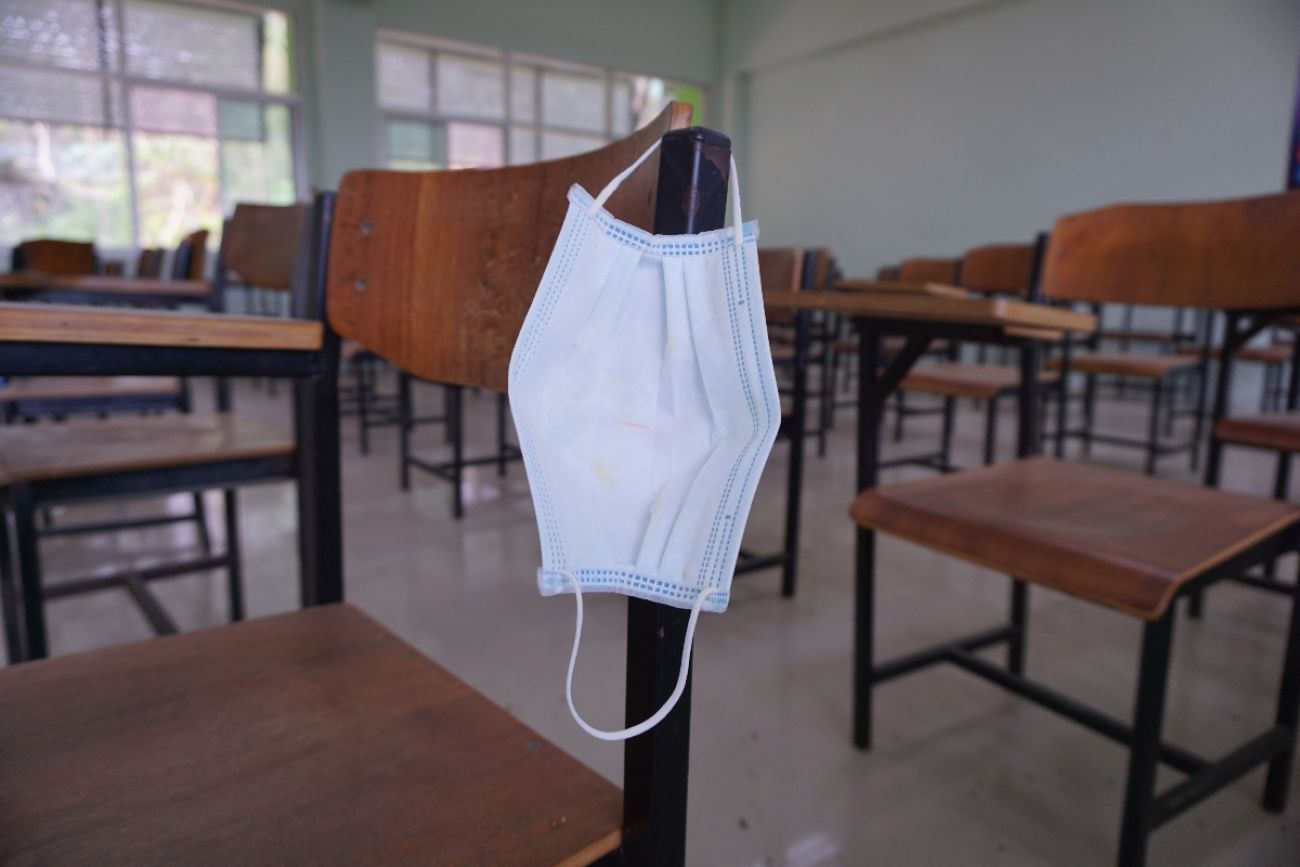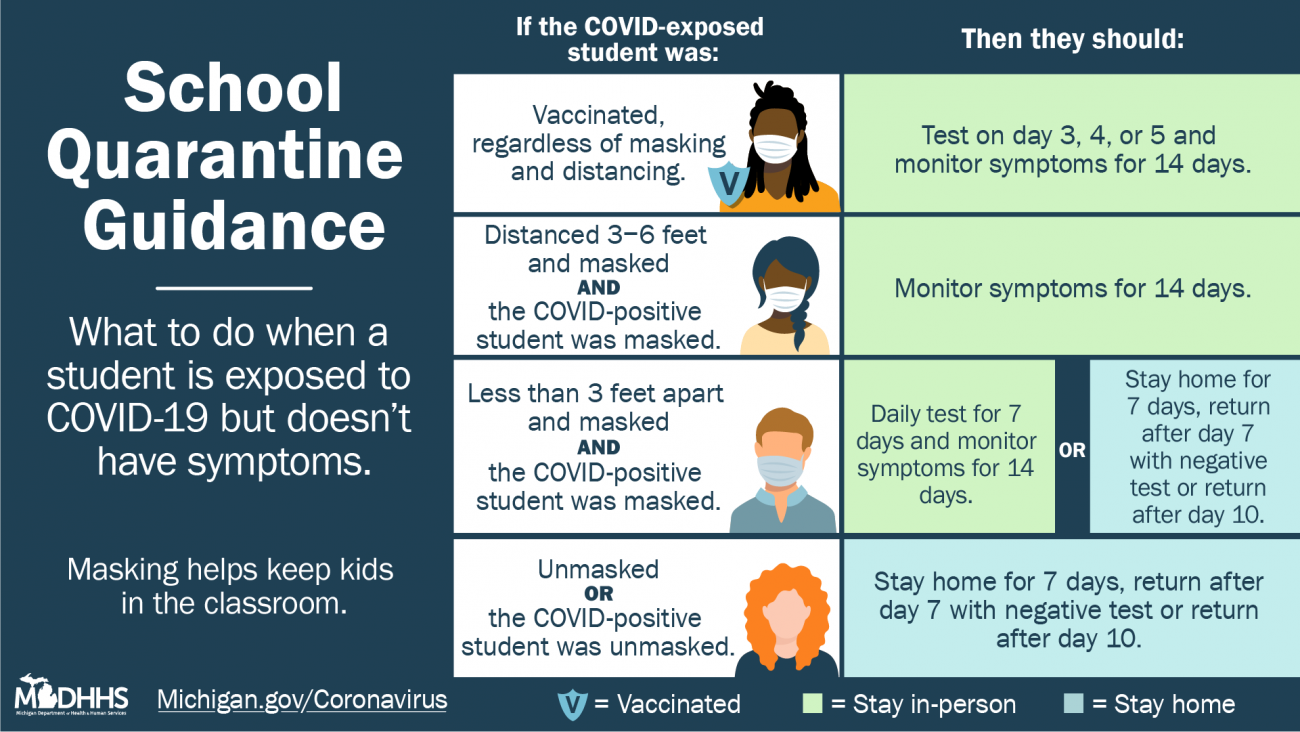Michigan: Masked or vaxxed students more likely to avoid COVID quarantine

Oct. 4: COVID outbreaks in Michigan schools already 8 times higher than last year
Sept. 30: Michigan counties dump mask rules for thousands of pupils amid budget mess
Sept. 30: Science says school masks work. Public opinion is another issue in Michigan
Sept. 14: Republicans advance bills to bar Michigan school mask mandates
Just days into the new school year, the Whitmer administration has stepped up pressure to mask and vaccinate students in classrooms, issuing new guidance Wednesday that excuses children exposed to COVID from quarantine if they were following safety protocols at the time.
The updated recommendations allow more students to remain in school, even if they have been exposed, as long as both students — the infected student and the one exposed — wore masks, or if the exposed student is vaccinated.
That marks a significant change from last year’s state orders, which called for quarantining all staff and students found to be in close contact with someone infected by COVID-19.
Related:
- Detroit students hustle into class, masked up and temperature checked
- COVID surge has largely missed Michigan. Has the state dodged a bullet?
- More Michigan 3rd-graders struggled to read amid COVID, remote learning
- See how your Michigan school fared in the 2021 M-STEP test
The new guidance could be a “game changer” for schools who need to focus on educating, said Eric Pessell, health officer for the Calhoun County Health Department.
Wednesday’s guidance by the Michigan Department of Health and Human Services (MDHHS), coupled with local mask mandates that require the majority of Michigan students statewide to wear face coverings, will likely lessen the number of students who must miss school this year because of quarantine orders, Pessell and school leaders told Bridge Michigan.
Last school year, it was common for 10 to 25 students to be ordered to stay home from school for 10 days for every one student who tested positive, under a policy of quarantining all students and staff exposed for a prolonged period to someone who tested positive for the virus.
Generally, students and staff last year were considered exposed if they were within six feet of the infected person for 15 minutes. The new recommendations carve broad exemptions for students who take basic COVID health precautions.
The goal of the new guidelines is to offer flexibility to local districts, according to Lynn Sutfin, spokesperson for MDHHS.
“The local health department may modify quarantine policies based on different factors, including how close the contact is, the duration and intensity of the contact, if the students were wearing masks, and what is happening in the local community,” she told Bridge Michigan in an email. “Schools and local health departments should work together to decide what quarantine policies work best in their community.”
Peter Spadafore, spokesperson for the Michigan Association of Superintendents and Administrators, said the guidelines will likely incentivize school districts to encourage or mandate mask-wearing.
“I’m not sure it's going to change (policies in) every district, but it does spell out a clearer path for students returning to the classroom faster when there isn’t a positive test.”
One district where the recommendations could be helpful is Harper Creek Community Schools — the only one of Calhoun County’s largest school districts not to require masks — where 22 confirmed cases among staff and students have led to 192 quarantines since the beginning of school Aug. 23, Pessell said.
Should Harper Creek and other districts adopt the state guidelines, some of those students would be allowed to “test out” of quarantine, he said.
The guidance comes as K-12 students return to public classrooms amid concern about the continuing pandemic and heated public debate over school mask mandates. As the pandemic stretches well into its second year, there is growing consensus on the importance of returning students to classrooms for their well-being and academic success. Extensive quarantines such as the ones enforced statewide last year would endanger in-person learning.
The new, more flexible quarantine recommendations could be a boon for the roughly 60 percent of Michigan students currently required to wear face coverings in classrooms, under mandates either from school districts or local health departments.
In a statement following the release of the quarantine guidance, Gov. Gretchen Whitmer applauded schools and health departments that have issued mask mandates. Whitmer has declined to issue a statewide mask mandate similar to the face mask requirement ordered during the 2020-21 school year. (Check which school districts currently have mask mandates here.)
In a statement, Elizabeth Hertel, MDHHS director, called the new quarantine guidance part of a “layered” approach to keeping COVID under control, in addition to masking, social distancing, testing and isolation. While vaccinations have been lauded as the best way to stop COVID, none of the three vaccines available in the United States are yet authorized for children younger than 12.
But one school official said she is frustrated by the timing of the guidance — two days after many schools opened classrooms for the fall term, rather than a month ago when schools and local health officials could have adjusted protocols more easily to align with state health guidance.
“We knew when school was starting, and we’ve known it for some time … The planning that would have to be done to be effective at any of these occurred a month ago,” said Jessica Harrand, superintendent of Buckley Community Schools in northwest Michigan.
The Buckley district had already finalized its COVID plan, spent more than $800 on printing and postage, and distributed it to the community, she said.
Still, an “overarching policy” can still be helpful, especially for districts like Buckley, which straddle counties or health departments.
“What's tricky for me is that I can't quarantine a student from Grand Traverse County based on one set of rules and a student for Wexford County based on a second set of rules,” Harrand said.
She and others noted, though, that the guidance is a recommendation, not an edict. The Whitmer administration has put the onus on local districts and health departments to set school policies relating to COVID. As a result, it’s unclear how large of an impact the guidance will have in Michigan schools.

In the week between Aug. 27 and Sept. 2, the number of new and ongoing coronavirus outbreaks in K-12 schools grew from 14 to 44, with the total cases in those outbreaks rising from 40 to 190, according to data released by the state Tuesday. It’s an increase, but still miniscule considering the roughly 1.5 million students in state K-12 education.
Among schools with early outbreaks, nine have mask mandates and 17 do not.
The new guidance is similar to protocols many districts and health offices have plotted for the fall, said Robert McCann, executive director of the K-12 Alliance for Michigan, an advocacy organization with close ties to many of the state’s largest school districts.
Under the new state guidance, a student who has tested positive for COVID-19 should isolate and follow directions from their local health department, and any individual with COVID-19 symptoms, regardless of vaccination status, should be tested and be isolated.
But then it gets a lot more complicated.
Under the new guidance, a student exposed to COVID-19 could nevertheless remain in school if:
- They are fully vaccinated, even if they didn’t wear a mask and even if they were in close contact with a COVID-positive student. However, they should test for COVID-19 three to five days after their last exposure, wear a mask, and monitor symptoms for 14 days after the exposure.
- They wore masks, even if they were unvaccinated, as long as the students remained at least three to six feet apart, if the infected person was also wearing a mask. However, the exposed student must continue wearing a mask, and should monitor symptoms for 14 days following the exposure.
- They wore masks, even if they were unvaccinated and the students were less than three feet apart. However, the exposed student must continue wearing a mask, test daily for seven days and monitor for symptoms for 14 days. Alternatively, the exposed student can stay out of school for seven days and return with a negative test result, or stay home for 10 days without a test.
Some details will be hammered out at the local level, said Pessell, the health officer from Calhoun County.
While schools can obtain free antigen tests and supplies through the MI Safe Schools Testing program and the Mi Safer Schools, who will be responsible for administering COVID tests to students who want to “test out” of quarantine and return to school?
“A simple home test given by mom or dad probably isn’t going to work. I don’t have the staff time to have them send me a home test...to review,” Pessell said.
Calhoun County’s health staff is already “buried … in cases, quarantines, contact tracing,” Pessell said.
The language of the state’s guidance is specific to students, and doesn’t spell out quarantine policies for teachers and staff. And Harrand, of the Buckley district, noted another impediment to implementing such a policy: She said she can ask students if they have been vaccinated, but can’t demand that information.
Contact tracing and quarantining are crucial to keeping COVID under control, especially because infected and contagious individuals can be asymptomatic. But allowing some students to return with safeguards makes sense, too, said Pessell, the health officer.
“We need to keep in mind that the goal here is to keep as many kids in school as possible,” he said.
Michigan Education Watch
Michigan Education Watch is made possible by generous financial support from:
Subscribe to Michigan Education Watch
See what new members are saying about why they donated to Bridge Michigan:
- “In order for this information to be accurate and unbiased it must be underwritten by its readers, not by special interests.” - Larry S.
- “Not many other media sources report on the topics Bridge does.” - Susan B.
- “Your journalism is outstanding and rare these days.” - Mark S.
If you want to ensure the future of nonpartisan, nonprofit Michigan journalism, please become a member today. You, too, will be asked why you donated and maybe we'll feature your quote next time!






